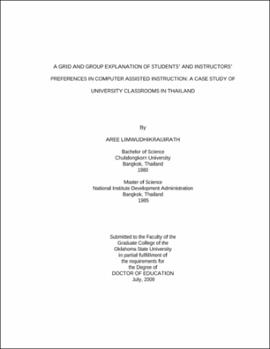| dc.contributor.advisor | Harris, Edward | |
| dc.contributor.author | Limwudhikraijirath, Aree | |
| dc.date.accessioned | 2013-11-26T08:33:24Z | |
| dc.date.available | 2013-11-26T08:33:24Z | |
| dc.date.issued | 2009-07 | |
| dc.identifier.uri | https://hdl.handle.net/11244/7247 | |
| dc.description.abstract | Scope and Method of Study: This study was a case study which had three overlapping purposes. The first purpose was to use Douglas's typology to explain the educational culture of the Faculty of Management Sciences (FMS) at Prince of Songkla University (PSU) Hatyai, Songkhla, Thailand. The second purpose was to describe the students' and instructor's preferences about computer assisted instruction (CAI) in FMS. The last purpose was to describe CAI practices in FMS. The participants in this case study included students and instructors of FMS. Participants completed a questionnaire called the Grid and Group Cultural Preference Tool. The results from the tool aligned each participant with the corresponding quadrant of their own cultural context. Participants in the interview stage were selected because of their different cultural contexts. Data were triangulated by multiple sources: questionnaire responses, interview transcripts, classroom observations and observation field notes, as well as documents. | |
| dc.description.abstract | Findings and Conclusions: Findings in this study indicated that there were some similarities in the cultures of FMS students and FMS instructors, and some differences in their practices and preferences in CAI. Both FMS students and instructors were collectivist (low grid, high group). For instructors, work comes first. For some students, they worked and played computer games at the same time. Age may be the crucial factor of the level of their responsibility. FMS indicated a compromised low-grid environment. It exhibited strong influences from history and tradition and had excellent linkages with its communities. The findings also showed the modes of CAI that students and instructors liked most and liked least. If the FMS administrators have to choose only one mode to provide CAI for students, it should be simulation which fits with the collectivist cultural context. However, there were many suitable criteria for selecting mode of CAI. It depends on subject which was taught too. Douglas is useful in explaining behaviors in a cultural context. However, actions and behaviors are not determined only by the culture. There are other factors such as personality and family background that help shape behavior, but Douglas is helpful in offering cultural language to explain those actions and behaviors. | |
| dc.format | application/pdf | |
| dc.language | en_US | |
| dc.rights | Copyright is held by the author who has granted the Oklahoma State University Library the non-exclusive right to share this material in its institutional repository. Contact Digital Library Services at lib-dls@okstate.edu or 405-744-9161 for the permission policy on the use, reproduction or distribution of this material. | |
| dc.title | Grid and group explanation of students' and instructors' preferences in computer assisted instruction: A case study of university classrooms in Thailand | |
| dc.contributor.committeeMember | Dugger, Cecil | |
| dc.contributor.committeeMember | Hyle, Adrienne | |
| dc.contributor.committeeMember | Kelsey, Kathleen | |
| osu.filename | Limwudhikraijirath_okstate_0664D_10394.pdf | |
| osu.accesstype | Open Access | |
| dc.type.genre | Dissertation | |
| dc.type.material | Text | |
| dc.subject.keywords | computer assisted instruction | |
| dc.subject.keywords | cultural preference tool | |
| dc.subject.keywords | cultural theory | |
| dc.subject.keywords | e-learning | |
| dc.subject.keywords | grid and group | |
| dc.subject.keywords | modes of ca | |
| thesis.degree.discipline | Applied Educational Studies | |
| thesis.degree.grantor | Oklahoma State University | |
